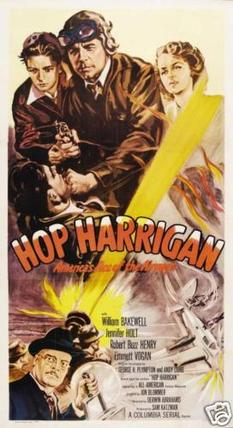| Hop Harrigan | |
|---|---|
 | |
| Directed by | Derwin Abrahams |
| Written by | Jon L. Blummer (adapted from the comic strip by) Ande Lamb (original screenplay) George H. Plympton (original screenplay) |
| Based on | |
| Produced by | Sam Katzman |
| Starring | William Bakewell Jennifer Holt Robert 'Buzz' Henry Sumner Getchell |
| Cinematography | Ira H. Morgan |
| Edited by | Earl Turner |
| Music by | Lee Zahler |
Production company | Sam Katzman Productions |
| Distributed by | Columbia Pictures |
Release date |
|
Running time | 15 chapter serial |
| Country | United States |
| Language | English |
Hop Harrigan (aka Hop Harrigan America's Ace of the Airways) (1946) is a Columbia film serial, based on the Hop Harrigan comic books by DC Comics. [1] The serial comprised 15 two-reel chapters with Derwin Abrahams as the director, and Sam Katzman, the producer. [2] Columbia Pictures was one of the last Hollywood studios to continue in postwar years with the serial format. By 1947, Universal Pictures discontinued their serials, with only Republic Pictures and Columbia continuing with serials. The last serial was Columbia's Blazing the Overland Trail (1956). [3]